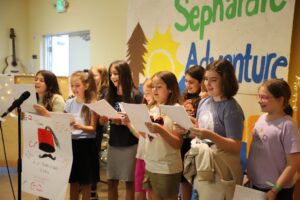Poetry Slam – Sephardic Style
Sephardic Poetry Slam
By Sara Aroeste | July 3, 2023
Sarika! Ke Haber, Sarika! This is how I was greeted by campers this week who remembered me from my visit last summer. To be recognized from one summer to the next is one thing, but to have the children call out to me in Ladino is a whole other level of joy for me. As a Sephardic educator whose life has been built on teaching the beauty and richness of Ladino, witnessing kids putting it to use during the camp experience is truly a highlight of my summer.
This year I came to camp to try out a new activity – a Sephardic Poetry Slam! After giving a brief introduction on styles of Sephardic poetry, from varieties of coplas (a specific format of Sephardic poem), to types of rhyming patterns, I laid out the simple rules. Each bunk would create its own poem that had to meet the following conditions: 1) There had to be one Ladino refran (saying or proverb); 2) There had to be one use of a Sephardic symbol (think hamsa, bureka, fez etc.); 3) There had to be at least one rhyming couplet; and lastly, 4) There had to be mention of this year’s camp theme, “adio kerida” (or “goodbye, my beloved”, a nod to the golden age of Spain). Extra points could be given for illustration or any musical accompaniment (i.e. drumming, beat-boxing, singing etc.). Overall, the idea was to have FUN. To maximize it?
We put the emphasis on the “slam” part of the Poetry Slam, which is traditionally known as an open mic experience for performers to riff in rhythmic poetic forms. The SAC version of the poetry slam called for bunks to be silly and to rib each other, all while professing the many reasons why they love SAC.
The result was pure hilarity…and pride! Each bunk, from the youngest to the oldest, showed off their cooperative skills by writing poems together that incorporated bits of Ladino, Sephardic symbolism, proverbs and so much more. The children (as well as a group of counselors!) all rose to the occasion and performed their poems in front of a packed audience of campers and SAC guests. Even the children who thought they couldn’t do it each found ways to participate and add to the bunk bonding experience.
In the end, I don’t know who was prouder of how everyone performed – me or the campers.

